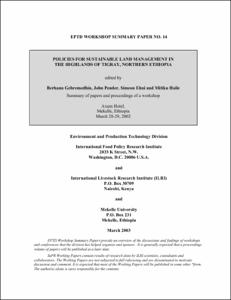Policies for sustainable land management in the highlands of Tigray, northern Ethiopia
The papers presented at this workshop dealt with a wide array of topics related to land management in the highlands of Tigray.
Politiques sur les forêts et l’adaptation aux changements climatiques au Cameroun
Poster on ecosystem services for agriculture development: a new way to look at sustainability
Planeamiento de actividades en el establecimiento de una pastura
Potential animal production and management of pastures and ultisol soil in Colombia
Policies for improved land management and agricultural market development in the Ethiopian highlands
“The objectives of this workshop are to review and discuss the main findings and policy implications of recent research conducted on these topics by IFPRI, Wageningen University and Research Center (WUR), the International Livestock Research Institute (ILRI), Mekelle University (MU), the Ethiopian Agricultural Research Organization (EARO) and other Ethiopian collaborators; to discuss options for improving the development of agricultural markets and land management in Ethiopia, considering different stakeholders’ perspectives; and to develop recommendations for priority policy actions and fu
Proceedings of the Launching Workshop of the Agricultural Water Management Platform, Addis Ababa, Ethiopia, 15-16 January 2015
Practitioners' guide book on the best agricultural practices for drought and floods in Sri Lanka [Guide book development team includes B.R. Ariyaratne of IWMI].
Proceedings of the Workshop on Irrigation in West Africa: Current Status and a View to the Future, Ouagadougou, Burkina Faso, 1-2 December 2010
Praderas tropicales mejoradas a base de leguminosas forrajeras
La inclusión de una leguminosa apropiada en la vegetación de las praderas tropicales y la corrección de las deficiencias minerales en la nutrición de las plantas y de los animales, contribuiría a desarrollar una mayor producción ganadera. Muchas de las leguminosas tropicales, son de origen americano, toleran la acidez del suelo y el bajo contenido de fósforo. La selección y el fitomejoramiento permitirían la incorporación de características agronómicas deseables, tales como un mejor índice de crecimiento, mayor resistencia al pastoreo y facilidad de recolección de semillas.




